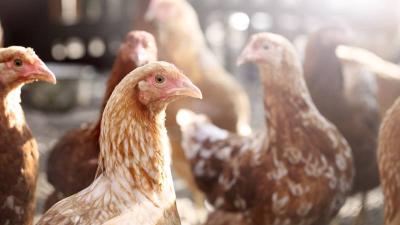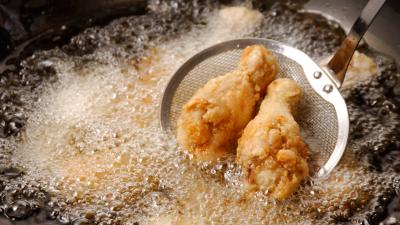Chicken Is Not a Healthy Choice
Chicken products contain cholesterol, carcinogens, and contaminants.
Cholesterol, carcinogens, pathogens, and even feces found in chicken products increase the risk of heart disease, breast and prostate cancers, urinary tract infections, and foodborne illnesses.
Carcinogens
Carcinogens occur naturally in chicken. In a Physicians Committee study compiled from independent laboratory tests, 100% of 100 grilled chicken samples from top restaurant chains in California contained PhIP, a federally recognized carcinogen that has been linked to breast, prostate, and other cancers.1 PhIP forms naturally from substances found in tissue when the tissue is exposed to direct high heat. Certain cooking factors appear to increase PhIP concentrations more than others, including longer cooking time, higher internal temperature, and greater degree of surface browning.2
Heterocyclic amines (HCAs) are other compounds that have been linked to cancer since the 1970s. These compounds form when meat is cooked. Cooking chicken at higher temperatures, for a longer duration, and with the skin on increases the amounts of HCAs generated.3
Heme iron is the form of iron found in animal products (compared to non-heme iron which is found in plants). Though its consumption is often promoted as it is more readily absorbed than non-heme iron, heme iron has been linked to an increased risk of colorectal cancer, type 2 diabetes, and heart disease.4-6
Cholesterol
Chicken also raises cholesterol levels as much as red meat. Researchers tested the effects of low-saturated-fat diets that drew their protein from red meat (beef and pork), white meat (chicken and turkey), or nonmeat sources (legumes, nuts, grains, and soy products).7 It turned out that both white and red meat raised LDL (“bad”) cholesterol, compared with plant-based proteins, and did so to about the same extent.
In addition to dietary cholesterol, typical chicken servings are about 50% fat, and 30% of that is saturated or “unhealthy” fat, which stimulates the body’s production of cholesterol.
Poultry Pathogens
The Centers for Disease Control and Prevention estimates that every year about 1 million people get sick from eating poultry products contaminated with harmful germs. A 2017 study found that poultry accounted for the highest number of foodborne outbreaks, illnesses, and hospitalizations, and the second-highest number of deaths.8
Centers for Disease Control and Prevention (CDC) research shows that foodborne illnesses from bacteria found in chicken are on the rise. In 2018, Campylobacter infections increased 12%, compared to 2015-2017, and Salmonella infections increased 9%.9
Since 2013, Campylobacter—which causes diarrhea, sometimes bloody, and hospitalizations for 18% of people—has caused the most foodborne infections.
Salmonella is the second most common cause of foodborne illness, which can cause diarrhea, fever, and abdominal cramps. In December 2018, the U.S. Department of Agriculture Food Safety and Inspection Service reported that 22% of establishments that produce chicken parts failed to meet the salmonella performance standard.9
Urinary Tract Infections
E. coli found in chicken feces may be a major cause of urinary tract infections. A 2018 study found that a strain of E. coli—E. coli ST131—found in retail chicken products can be passed to people, leading UTIs.9 E. coli ST131 is particularly adept at traveling from the bladder to the blood and kills thousands of people in the United States each year, according to the study.10
An earlier study published by the CDC examined urine samples from women who had UTIs and matched E. coli in the samples to E. coli from contaminated foods.11 They found that most of the E. coli was ingested through retail meat products (61% of which were chicken products) and ready-to-eat products (73% of which were meat products). The authors concluded that chicken was the main source of urinary-tract-infection-causing E. coli. The researchers also warned that animal product sources of E. coli might be drug-resistant which can require more costly and complicated treatments.
And a 2023 study found that approximately 8% of E. coli urinary tract infections in the United States (or between 480,000 to 640,000 cases) were caused by bacteria strains present in and consumed through meat.12
According to the World Health Organization (WHO), up to 80% of total antibiotic consumption in many countries is by the animal agriculture sector. The overuse and misuse of antibiotics in animals contributes to the rising threat of antibiotic-resistant infections that can spread to humans.13
More than 2.8 million antibiotic-resistant infections occur in the United States each year, and more than 35,000 people die as a result, according to the CDC’s 2019 Antibiotic Resistance Threats Report.14 An analysis of over 1,000 poultry samples from nationwide Korean stores found that 87.9% of the E. coli strains present in chicken were resistant to multiple antibiotics.15 In Arizona, 88% of chicken samples tested were contaminated with E. coli, and multidrug-resistant strains of E. coli were found in conventional chicken, chicken raised with antibiotics, and organic chicken.16
‘Fecal Soup’
The Physicians Committee sued the U.S. Department of Agriculture in 2019 for ignoring concerns over widespread fecal contamination of chicken products. The lawsuit followed USDA unresponsiveness to a Physicians Committee petition that included results from tests conducted on 120 chicken products sold by 15 grocery store chains in 10 U.S. cities. Evidence of fecal contamination was found in 48% of samples.
Although the USDA implements a “zero tolerance” policy for fecal contamination, this policy only applies to visible fecal contamination. Chicken products pass inspection as long as feces are not visible to the naked eye.
The lawsuit and petition quote a federal inspector who said, “We often see birds going down the line with intestines still attached, which are full of fecal contamination. If there is no fecal contamination on the bird’s skin, however, we can do nothing to stop that bird from going down that line. It is more than reasonable to assume that once the bird gets into the chill tank (a large vat of cold water), that contamination will enter the water and contaminate all of the other carcasses in the chiller. That’s why it is sometimes called ‘fecal soup.’”
Fecal Soup: Poultry Slaughter Procedures
“Poultry Slaughter Procedures,” a USDA training video obtained by the Physicians Committee through a Freedom of Information Act request made in 2013, revealed that the chicken slaughtering process ends with carcasses soaking in cold water - “fecal soup” - for up to one hour before being packaged for consumers.
Chicken is a major contributor to foodborne illnesses, antibiotic resistance, zoonotic diseases, and other chronic illnesses. We should be actively avoiding chicken and instead focusing on plant-based sources of protein.
Roxanne Becker, MBChB, DipIBLM, Medical Editor and Educator, Physicians Committee
Plant-Powered Prescription for Chicken
- Replace chicken with plant-based sources of protein, such as tofu, beans, and nuts.
Think Chicken Is Healthy?
We get to the truth about chicken!
More on Chicken
DID YOU KNOW?
Chicken may not be better than beef.
References
- Sullivan KM, Erickson MA, Sandusky CB, Barnard ND. Detection of PhIP in grilled chicken entrées at popular chain restaurants throughout California. Nutr Cancer. 2008;60(5):592-602. doi:10.1080/01635580801956519
- Sinha R, Rothman N, Brown ED, et al. High concentrations of the carcinogen 2-amino-1-methyl-6-phenylimidazo- [4,5-b]pyridine (PhIP) occur in chicken but are dependent on the cooking method. Cancer Res. 1995;55(20):4516-4519.
- Pleva D, Lányi K, Monori KD, Laczay P. Heterocyclic amine formation in grilled chicken depending on body parts and treatment conditions. Molecules. 2020;25(7):1547. doi:10.3390/molecules25071547
- Bastide NM, Pierre FH, Corpet DE. Heme iron from meat and risk of colorectal cancer: a meta-analysis and a review of the mechanisms involved. Cancer Prev Res (Phila). 2011;4(2):177-184. doi:10.1158/1940-6207.CAPR-10-0113
- Bao W, Rong Y, Rong S, Liu L. Dietary iron intake, body iron stores, and the risk of type 2 diabetes: a systematic review and meta-analysis. BMC Med. 2012;10:119. doi:10.1186/1741-7015-10-119
- Hunnicutt J, He K, Xun P. Dietary iron intake and body iron stores are associated with risk of coronary heart disease in a meta-analysis of prospective cohort studies. J Nutr. 2014;144(3):359-366. doi:10.3945/jn.113.185124
- Bergeron N, Chiu S, Williams PT, M King S, Krauss RM. Effects of red meat, white meat, and nonmeat protein sources on atherogenic lipoprotein measures in the context of low compared with high saturated fat intake: a randomized controlled trial. Am J Clin Nutr. 2019;110(1):24-33. doi:10.1093/ajcn/nqz035
- Chai SJ, Cole D, Nisler A, Mahon BE. Poultry: the most common food in outbreaks with known pathogens, United States, 1998-2012. Epidemiol Infect. 2017;145(2):316-325. doi:10.1017/S0950268816002375
- Tack DM, Marder EP, Griffin PM, et al. Preliminary incidence and trends of infections with pathogens transmitted commonly through food — foodborne diseases active surveillance network, 10 U.S. sites, 2015–2018. MMWR Morb Mortal Wkly Rep. 2019;68:369–373. doi:10.15585/mmwr.mm6816a2
- Liu CM, Stegger M, Aziz M, et al. Escherichia coli ST131-H22 as a foodborne uropathogen. mBio. 2018;9(4):e00470-18. doi:10.1128/mBio.00470-18
- Vincent C, Boerlin P, Daignault D, et al. Food reservoir for Escherichia coli causing urinary tract infections. Emerg Infect Dis. 2010;16(1):88-95. doi:10.3201/eid1601.091118
- Liu C, Maliha A, Park D, et al. Using source-associated mobile genetic elements to identify zoonotic extraintestinal E. coli infections. One Health. 2023:100518. doi:10.1016/j.onehlt.2023.100518
- World Health Organization. Stop using antibiotics in healthy animals to prevent the spread of antibiotic resistance. November 7, 2017. Accessed February 9, 2024. https://www.who.int/news/item/07-11-2017-stop-using-antibiotics-in-healthy-animals-to-prevent-the-spread-of-antibiotic-resistance
- Centers for Disease Control and Prevention. Antibiotic resistance threats in the United States. Page last reviewed November 23, 2021. Accessed February 9, 2024. https://www.cdc.gov/drugresistance/biggest-threats.html
- Kim S, Kim H, Kim Y, Kim M, Kwak H, Ryu S. Antimicrobial resistance of Escherichia coli from retail poultry meats in Korea. J Food Prot. 2020;83(10):1673-1678. doi:10.4315/JFP-20-150
- Davis GS, Waits K, Nordstrom L, et al. Antibiotic-resistant Escherichia coli from retail poultry meat with different antibiotic use claims. BMC Microbiol. 2018 3;18(1):174. doi:10.1186/s12866-018-1322-5








